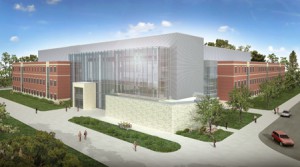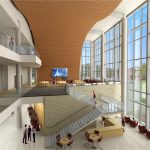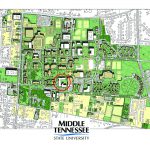Take a Digital Tour of the New MTSU Science Building
| April 30, 2013
Filed Under: President's Post, Featured Articles
MTSU's enrollment has almost quadrupled in the last 43 years—from 6,779 students in 1968 to 26,442 in fall 2011—with no increase in space for science education. The University's existing Wiser-Patten Science Hall and Davis Science Building were built in 1932 and 1967, respectively, and have a combined total of only 75,332 net square feet.
The new MTSU Science Building will provide more than 250,000 gross square feet of teaching, faculty and student research laboratories and collaborative learning spaces. At least 80 percent of all MTSU students will take at least one class in the new building.
MTSU broke ground for the new Science Building May 3, 2012. (Watch the video below.) The facility is being constructed on the south side of campus adjacent to the James E. Walker Library on the site of the old Wood, Felder, Gore and Clement dorms.
Requested funding:
- Gov. Bill Haslam included a $126.7 million capital-outlay funding request for the MTSU Science Building in his fiscal year 2012-13 budget. The General Assembly approved the budget April 30.
- The new Science Building was the No. 1 priority in the MTSU Capital Outlay Funding Request, the No. 1 priority in the Tennessee Higher Education Commission’s Five-Year Capital Projects Plan and the No. 1 capital project request of the Tennessee Board of Regents.
- The University's 1991 and 1998 Master Plans identified the significant need for additional science space. The MTSU Science Building project was placed on the TBR Capital Outlay Priority List in 1998.
- About $20 million has already been spent to prepare for construction of the Science Building. That money funded a new campus chilling plant, distribution lines, planning, site preparation and demolitions of the old dorms.
- MTSU modeled 12 science buildings at other institutions in developing the plan for its new Science Building. The average cost for those 12 comparison facilities was $463.42 per gross square foot. MTSU selected the most similar example, the science building at the University of Alabama-Huntsville (bid January 2005). UAH’s comparative cost was $379/GSF, and MTSU’s target cost in planning was $380/GSF.
- The MTSU project is only 16 percent larger than the Science Building at Austin Peay State University, yet MTSU has three times the number of APSU’s full-time enrolled students. With the new Science Building at MTSU, the density factor, or space available for each student, will be 149 square feet per full-time enrollee. The TBR's current average density factor at its universities is 210 square feet per FTE.
- Grounded in MTSU’s rich tradition of teacher training, the new MTSU Science Building will make full use of technology and contemporary research in teaching cognitive science. The entire facility will feature pedagogical design attributes nationally recognized as Project Kaleidoscope Initiatives, including discovery-based, group learning environments and spaces for informal discussion and collaborative interaction, all promoting an enhanced, 21st-century science education and research continuum.
- Nearly all of MTSU’s 26,000-plus students will benefit from the improved science facilities. During fall 2010, more than 13,200 students, both majors and non-majors, were enrolled in biology, chemistry and physical science courses. Biology is a general-education requirement at MTSU, and science courses produce about 60,000 credit hours annually at the University.
- Science courses to be offered in the new building serve academic programs beyond general education, biology and chemistry. Those additional programs include aerospace, agribusiness/agriscience, engineering technology, nursing, physics and astronomy, elementary education, teacher licensure in science education, wellness and exercise science in health and human performance, human sciences nutrition/food science/dietetics, geology, social work, and recording-industry production technology.
- During the academic year 2009-10, MTSU granted almost 700 degrees in biology, chemistry and related fields. The University estimates that number could increase by 25 percent after the new Science Building is in operation.
- Construction of the new Science Building will begin immediately after the May 3 groundbreaking, and the facility could be ready for use by spring 2015.
- enable the University to address needs identified in the America Competes Act by creating additional science graduates to fill high-technology jobs and teach science and math in K-12 schools;
- enhance middle Tennessee’s regional economy by providing technical entrepreneurs and researchers who launch small businesses through ideas and research;
- make MTSU and the state more competitive for federal grants and contracts in all areas of science, technology, engineering and mathematics; and
- support greater collaboration with Oak Ridge National Labs through MTSU’s new science doctoral programs.






